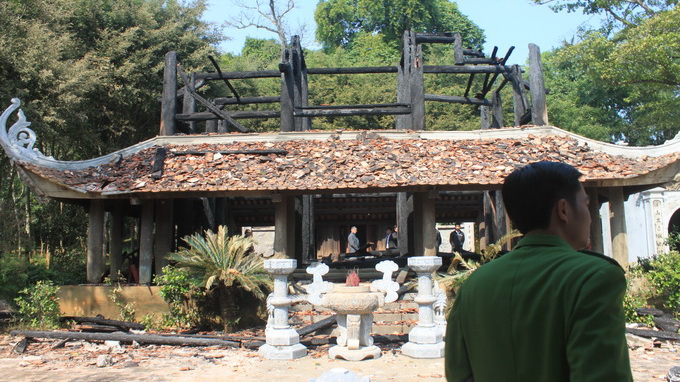Fire safety and prevention has been neglected or remained inadequate at most local relics though a number of fires took place and caused massive destruction and irreparable cultural loss.
In late October 2013, a fire, caused by the negligence of a group of tourists, consumed the only surviving century-old heritage house of ancient Muong ethnic culture in northern Hoa Binh city. On Dec 1, the temple dedicated to the hero Le Lai, who sacrificed himself to save his leader during the Lam Son uprising (1418-1427) in northern Thanh Hoa province, was also engulfed in flames. Both structures suffered massive damage and irreversible loss.
Fire also consumed the main hall of southern Soc Trang province’s hallmark Doi (Bat) Pagoda in 2007, the 600-year-old Tao Sach Pagoda in Hanoi in 2011, and a handful of century-old houses in Hoi An old town in central Quang Nam province in 2012 and 2013, along with several other relics throughout the country.
The omnipresent hazard
The fires at relic sites have posed a serious question of fire safety and prevention to the Department of Cultural Heritage, particularly as most relics are built from wood, which makes the structures considerably more flammable.
Though the department officials claimed that they have always made fire prevention an utmost priority, it seems not to be the case in reality.
Fire safety and prevention at many relics has been careless, with several sites lacking fire extinguishers. There are no fire warnings at Hanoi’s iconic Dien Huu – Mot Cot (One –Pillar) Pagoda, while its three fire extinguishers are covered with dust and stuffed in a closet.
Many other relics, such as Kim Co Pagoda, Hoa Temple, and several in Hanoi’s old quarter, are located in densely populated residential areas and are in dangerous proximity to electricity lines.
Though cultural officials repeatedly claimed to remind relic management of the importance of fire prevention in writing every year, the firefighting department asserted that the cultural department has never worked with them.
“The cultural department has yet to properly implement fire safety procedures simply because there has yet to be consensus in who really own the relics and who the responsibility should belong to,” explained Prof. Tran Lam Bien.
Meanwhile, architect Le Thanh Vinh from the Relic Preservation Institute put the inadequacy down to a lengthy waiting time, which ranges from a few years to a dozen years, to gain the funding to kickstart the restoration of relics.
“The relics continue to deteriorate during those waiting years and face even higher risks of fire and termite infestation. In addition, relic managements don’t receive state funding for regular maintenance, which would help considerably in minimizing fire hazards,” he noted.
Pham Thanh Nam, from the Ho Chi Minh City Department of Culture, Sports, and Tourism, acknowleged the high fire perils at relics citywide.
He also called for large-scale projects to provide funding and fire safety infrastructure and technology to relics, particularly wooden ones.
Nam also pointed out that temples in suburban areas, even those recognized as national relics, are usually left untended to and uninhabited, which aggravates the risk of fire.
UNESCO-recognized Hue city, Vietnam’s former imperial city, is home to relics that are mostly built from wood and are surrounded by pine forests and thus are highly susceptible to fire.
According to Nguyen Thanh Nam, from the Hue Relic Preservation Center, fires occur each year at its 16 main complexes.
One of the most serious fires took place in 1994, just before the Hue relic was granted recognition from UNESCO. The fire, caused by a staff member’s negligence in burning garbage, consumed the entire centennial pine forest within the tomb area of King Minh Mang, one of the Nguyen (1802-1945) kings.
“Fire is an omnipresent peril here, so security guards always keep watch and are ready for emergencies, though they remain short-staffed,” Nam elaborated.
Nam stressed that one of the most serious threats are the renovation sites, which are riddled with electric wires and full of wood shavings. Another is the careless burning of beehives and garbage in nearby forests or households adjacent to the relic complexes.
The most constant threat is from tourists smoking, although it is strictly forbidden at the complexes.
At the Dec 6 workshop on relic management in Hanoi, Dang Thi Bich Lien, deputy minister of Culture, Sports, and Tourism, stressed that steps be taken to reach a consensus in cultural heritage management.
Prof. Tran Xuan Bien also pointed to cultural leaders’ poor knowledge of cultural relics and their preservation.
He also urged that the management of fire-devastated relics be held accountable and strictly penalized.
| The Ministry of Culture, Sports and Tourism recently requested provincial cultural departments to tighten their check on fire safety in the 2014 festive season, particularly forbidding tourists from burning votive papers and minimizing incense burning inside the structures. |


















































